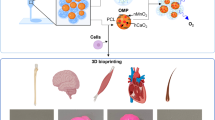Abstract
Poly (lactic-co-glycolic acid) (PLGA) is a biodegradable polymer used to make resorbable sutures, and is also used in other applications in tissue engineering. Being an artificial polymer, its degradation rate can be tailored to suit its application. It can be easily moulded into structures with suitable mechanical strength and degrades into relatively harmless products in the body. Its adjustable degradation rate also makes it a potentially excellent controlled release delivery device. However, the functionalization of PLGA with bioactive molecules usually requires extensive chemical modification. Chemical modification may compromise the mechanical strength of PLGA and inactivate the bioactive molecules. In this paper, a study is done to investigate the coating of an angiogenic factor on unmodified PLGA suture substrates for the differentiation of human mesenchymal stem cells (hMSC) into endothelial cells (EC). The results show that the method used to anchor vascular endothelial growth factor (VEGF) onto the PLGA surface can enable the gradual release of VEGF from the substrate into solution to induce the differentiation of hMSCs into ECs. Thus, this method can potentially be used to coat PLGA materials like sutures, meshes and scaffolds, rendering them functional as effective controlled release delivery devices for a wide range of bioactive molecules.




Similar content being viewed by others
References
Wen F, Chang S, Toh YC, Teoh SH, Yu H. Development of poly (lactic-co-glycolic acid)-collagen scaffolds for tissue engineering. Mater Sci Eng C. 2006;27:285–92. doi:10.1016/j.msec.2006.05.007.
Nakamura M, Abe Y, Tokunaga T. Pathological significance of vascular endothelial growth factor A isoform expression in human cancer. Pathol Int. 2002;52:331–9. doi:10.1046/j.1440-1827.2002.01367.x.
Sharon JL, Puleo DA. Immobilization of glycoproteins, such as VEGF, on biodegradable substrates. Acta Biomater. 2008;4:1016–23. doi:10.1016/j.actbio.2008.02.017.
Chu CC. Hydrolytic degradation of polyglycolic acid: tensile strength and crystallinity study. J Appl Polym Sci. 1980;26:1727–34. doi:10.1002/app.1981.070260527.
Lee ES, Na K, Bae YH. Polymeric micelle for tumor pH and folate-mediated targeting. J Control Release. 2003;91:103–13. doi:10.1016/S0168-3659(03)00239-6.
Stella B, Arpicco S, Peracchia MT, Desmaele D, Hoebeke J, Renoir M, et al. Design of folic acid-conjugated nanoparticles for drug targeting. J Pharm Sci. 2000;89:1452–64. doi:10.1002/1520-6017(200011)89:11<1452::AID-JPS8>3.0.CO;2-P.
Catiker E, Guner A, Gumusderelioglu M. Degradation of PLA, PLGA homo- and copolymers in the presence of serum albumin: a spectroscopic investigation. Polym Int. 2000;49:728–34. doi:10.1002/1097-0126(200007)49:7<728::AID-PI443>3.0.CO;2-3.
Gehling UM, Ergun S, Schumacher U, Wagener C, Pantel K, Otte M, et al. In vitro differentiation of endothelial cells from AC133-positive progenitor cells. Blood. 2000;95:3106–12.
Quirici N, Soligo D, Caneva L, Servida F, Bossolasco P, Deliliers GL. Differentiation and expansion of endothelial cells from human bone marrow CD133(+) cells. Br J Haematol. 2001;115:186–94. doi:10.1046/j.1365-2141.2001.03077.x.
Reyes M, Lund T, Lenvik T, Aguiar D, Koodie L, Verfaillie CM. Purification and ex vivo expansion of postnatal human marrow mesodermal progenitor cells. Blood. 2001;98:2615–25. doi:10.1182/blood.V98.9.2615.
Ennett AB, Kaigler D, Mooney DJ. Temporally regulated delivery of VEGF in vitro and in vivo. J Biomed Mater Res. 2006;79:176–84. doi:10.1002/jbm.a.30771.
Jackson DE. The unfolding tale of PECAM-1. FEBS Lett. 2003;540:7–14. doi:10.1016/S0014-5793(03)00224-2.
Oswald J, Boxberger S, Jorgensen B, Feldmann S, Ehninger G, Bornhauser M, et al. Mesenchymal stem cells can be differentiated into endothelial cells in vitro. Stem Cells. 2004;22:377–84. doi:10.1634/stemcells.22-3-377.
Chung HJ, Kim HK, Yoon JJ, Park TG. Heparin immobilized porous PLGA microspheres for angiogenic growth factor delivery. Pharm Res. 2006;23:1835–41. doi:10.1007/s11095-006-9039-9.
Lee H, Cusick RA, Browne F, Ho Kim T, Ma PX, Utsunomiya H, et al. Local delivery of basic fibroblast growth factor increases both angiogenesis and engraftment of hepatocytes in tissue-engineered polymer devices. Transplantation. 2002;73:1589–93. doi:10.1097/00007890-200205270-00011.
Perets A, Baruch Y, Weisbuch F, Shoshany G, Neufeld G, Cohen S. Enhancing the vascularization of three-dimensional porous alginate scaffolds by incorporating controlled release basic fibroblast growth factor microspheres. J Biomed Mater Res. 2003;65:489–97. doi:10.1002/jbm.a.10542.
Steffens GC, Yao C, Prevel P, Markowicz M, Schenck P, Noah EM, et al. Modulation of angiogenic potential of collagen matrices by covalent incorporation of heparin and loading with vascular endothelial growth factor. Tissue Eng. 2004;10:1502–9.
Huang YC, Kaigler D, Rice KG, Krebsbach PH, Mooney DJ. Combined angiogenic and osteogenic factor delivery enhances bone marrow stromal cell-driven bone regeneration. J Bone Miner Res. 2005;20:848–57. doi:10.1359/JBMR.041226.
Cohen H, Levy RJ, Gao J, Fishbein I, Kousaev V, Sosnowski S, et al. Sustained delivery and expression of DNA encapsulated in polymeric nanoparticles. Gene Ther. 2000;7:1896–905. doi:10.1038/sj.gt.3301318.
Cornetta K, Smith FO. Regulatory issues for clinical gene therapy trials. Hum Gene Ther. 2002;13:1143–9. doi:10.1089/104303402320138925.
Krebsbach PH, Gu K, Franceschi RT, Rutherford RB. Gene therapy-directed osteogenesis: BMP-7-transduced human fibroblasts form bone in vivo. Hum Gene Ther. 2000;11:1201–10. doi:10.1089/10430340050015248.
Peters MC, Polverini PJ, Mooney DJ. Engineering vascular networks in porous polymer matrices. J Biomed Mater Res. 2002;60:668–78. doi:10.1002/jbm.10134.
Sheridan MH, Shea LD, Peters MC, Mooney DJ. Bioabsorbable polymer scaffolds for tissue engineering capable of sustained growth factor delivery. J Control Release. 2000;64:91–102. doi:10.1016/S0168-3659(99)00138-8.
Simari RD, O’Brien T. Clinical trials in vascular gene therapy: the missing piece of the puzzle. Arch Pathol Lab Med. 2002;126:317–9.
Bensaid M, Malecaze F, Prats H, Bayard F, Tauber JP. Autocrine regulation of bovine retinal capillary endothelial cell (BREC) proliferation by BREC-derived basic fibroblast growth factor. Exp Eye Res. 1989;48:801–13. doi:10.1016/0014-4835(89)90065-1.
Backer MV, Patel V, Jehning BT, Claffey KP, Backer JM. Surface immobilization of active vascular endothelial growth factor via a cysteine-containing tag. Biomaterials. 2006;27:5452–8. doi:10.1016/j.biomaterials.2006.06.025.
Acknowledgement
This study is funded with a grant from the Singapore A*STAR/BMRC.
Author information
Authors and Affiliations
Corresponding author
Rights and permissions
About this article
Cite this article
Lim, T.Y., Poh, C.K. & Wang, W. Poly (lactic-co-glycolic acid) as a controlled release delivery device. J Mater Sci: Mater Med 20, 1669–1675 (2009). https://doi.org/10.1007/s10856-009-3727-z
Received:
Accepted:
Published:
Issue Date:
DOI: https://doi.org/10.1007/s10856-009-3727-z




